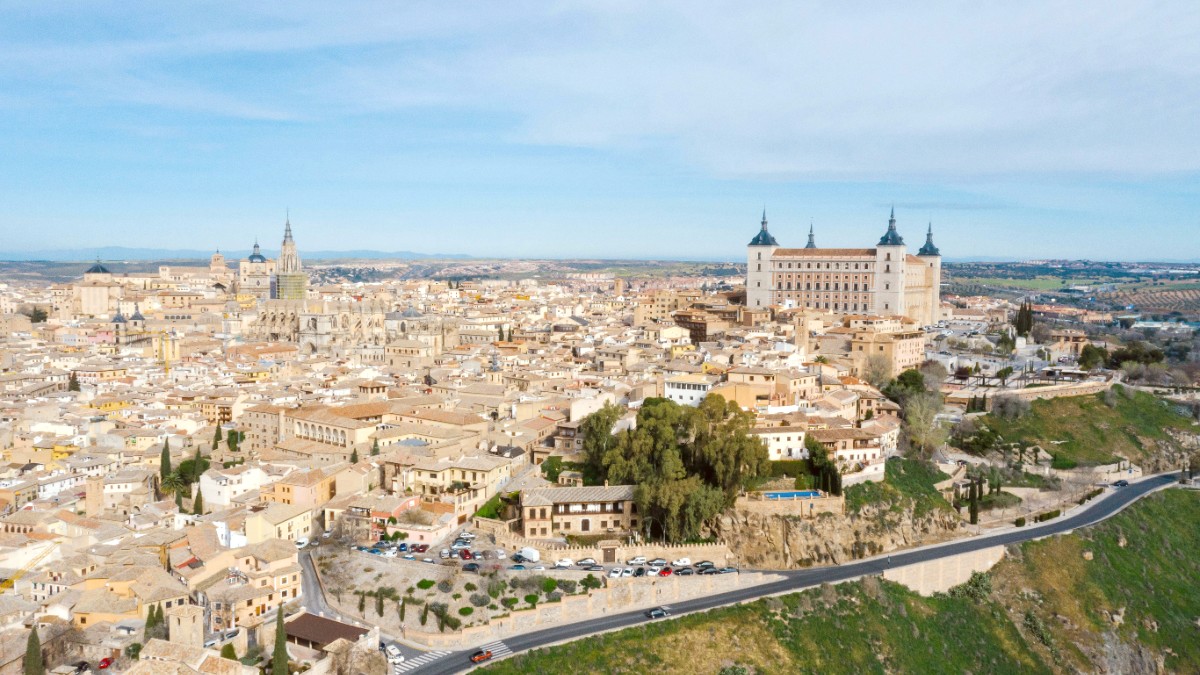
Castilla La Mancha, Spain
The winding lanes of Toledo hide courtyards, workshops, and eateries. Each corner is a new perspective, a different architectural detail, or a fresh scent from a local bakery. Toledo presents a sensory journey. Hear the distant toll of church bells, smell the aroma of traditional stews from a hidden restaurant, and feel the smooth, cool stone beneath your hand as you lean against a centuries-old wall.
Toledo occupies an unique geographical position in central Spain. It sits in the autonomous community of Castilla-La Mancha, a region known for its wide plains, historic towns, and rich cultural heritage. The city’s most defining geographical feature is its location on a rocky promontory. The Tagus River, Spain’s longest river, carves a deep gorge around three sides of this hill.
This natural defense made Toledo a strategic stronghold for centuries, influencing its development and military history. The city’s elevation gives it commanding views of the surrounding landscape. From various viewpoints, you observe the plains stretching towards the horizon. The river's presence enhances the city’s beauty, contrasting with the dense urban core.
Toledo is a distinguished place in Spanish history, a city whose past mirrors the nation’s complex formation. Its fame rests on its legacy as the "City of Three Cultures"—Christian, Jewish, and Muslim. For centuries, these three communities lived and worked side by side, building an unique environment of cultural exchange and intellectual growth.
Moorish architectural styles, with intricate geometric patterns and horseshoe arches, found integration into the city’s buildings. The Christian reconquest in 1085 let its multicultural identity continue for some time, leading to the Mudejar style, a distinct form of Christian art and architecture using Muslim techniques.
Early prominence as a center of power and religion.
Became a thriving intellectual and artistic hub, a symbol of learning.
Peaceful capture; continuation of multicultural identity for a period.
El Greco made Toledo his home, capturing its spiritual intensity.
Recognized for its unique urban landscape and monuments.
The synagogues, mosques, and churches serve as physical reminders of this complex past. The city's history is not just a collection of facts; it is embedded in its very structure.
This coexistence, though not without its challenges, brought forth a rich blend of art, architecture, and scholarship that stays visible today.
The city’s spiritual standing grew, becoming the seat of the Primate Archbishop of Spain. Today, Toledo preserves its historical layers with care.
Travelers benefit from this preservation, experiencing a city where every stone tells a story. UNESCO protection helps ensure this for future generations.
Toledo is a rich experience, compact enough for exploration over a few days, yet deep enough to warrant a longer stay. This city brings a direct connection to Spain’s diverse past, specifically its centuries of Christian, Jewish, and Muslim influence.
You will discover a city where the architecture narrates stories of coexistence and change. The Toledo Cathedral, a Gothic masterpiece, stands alongside ancient synagogues and a well-preserved mosque, all within easy walking distance.
Features hearty game dishes, delicious marzipan, and famous Manchego cheese.
Pedestrian-friendly historic core with public escalators and lifts.
Famous for Damascene craft and traditional sword-making.
Toledo welcomes various travel styles. History enthusiasts find endless material. Art lovers trace El Greco's presence. Those seeking relaxation find quiet spots. The city's size makes it manageable for families.